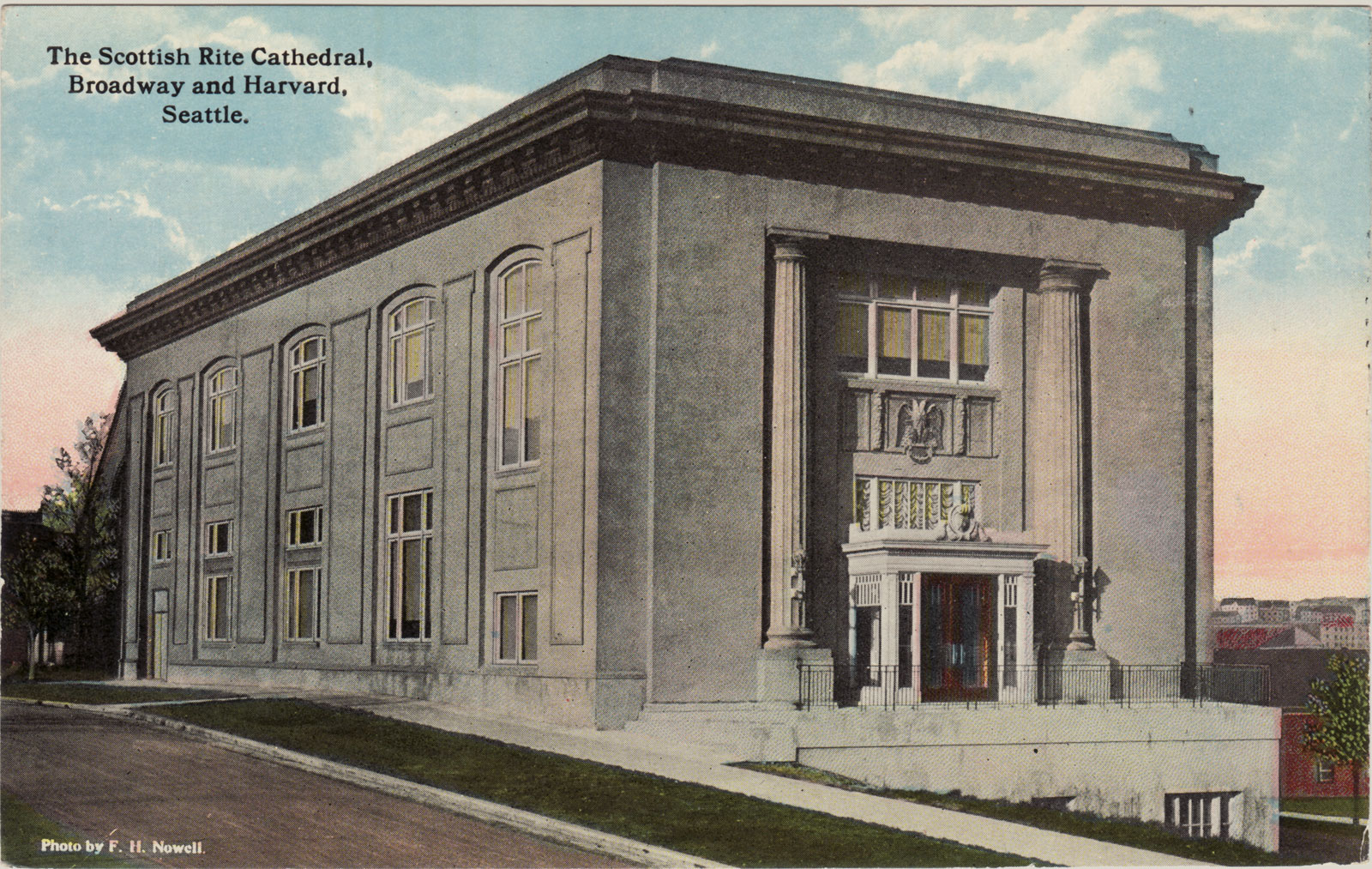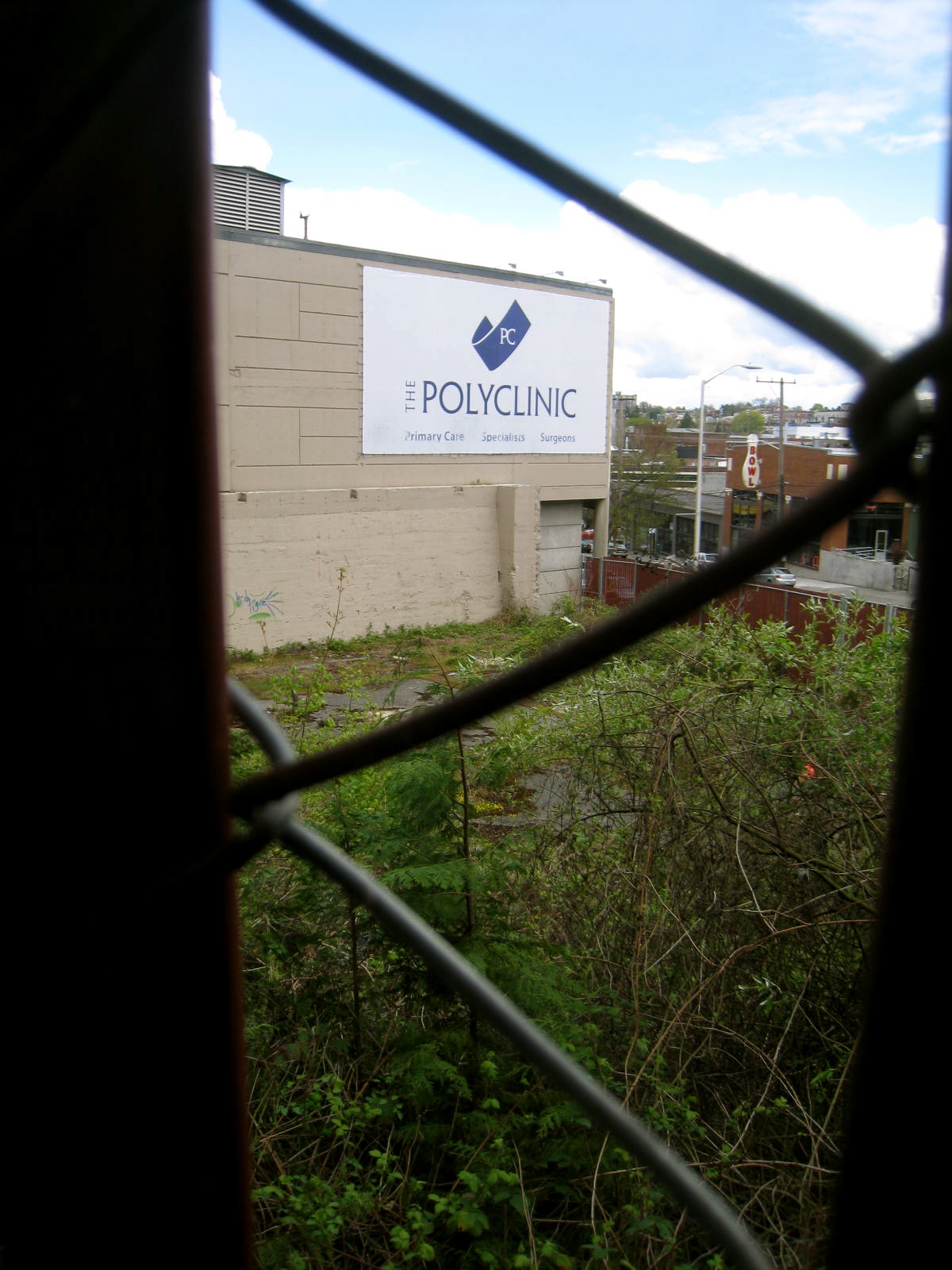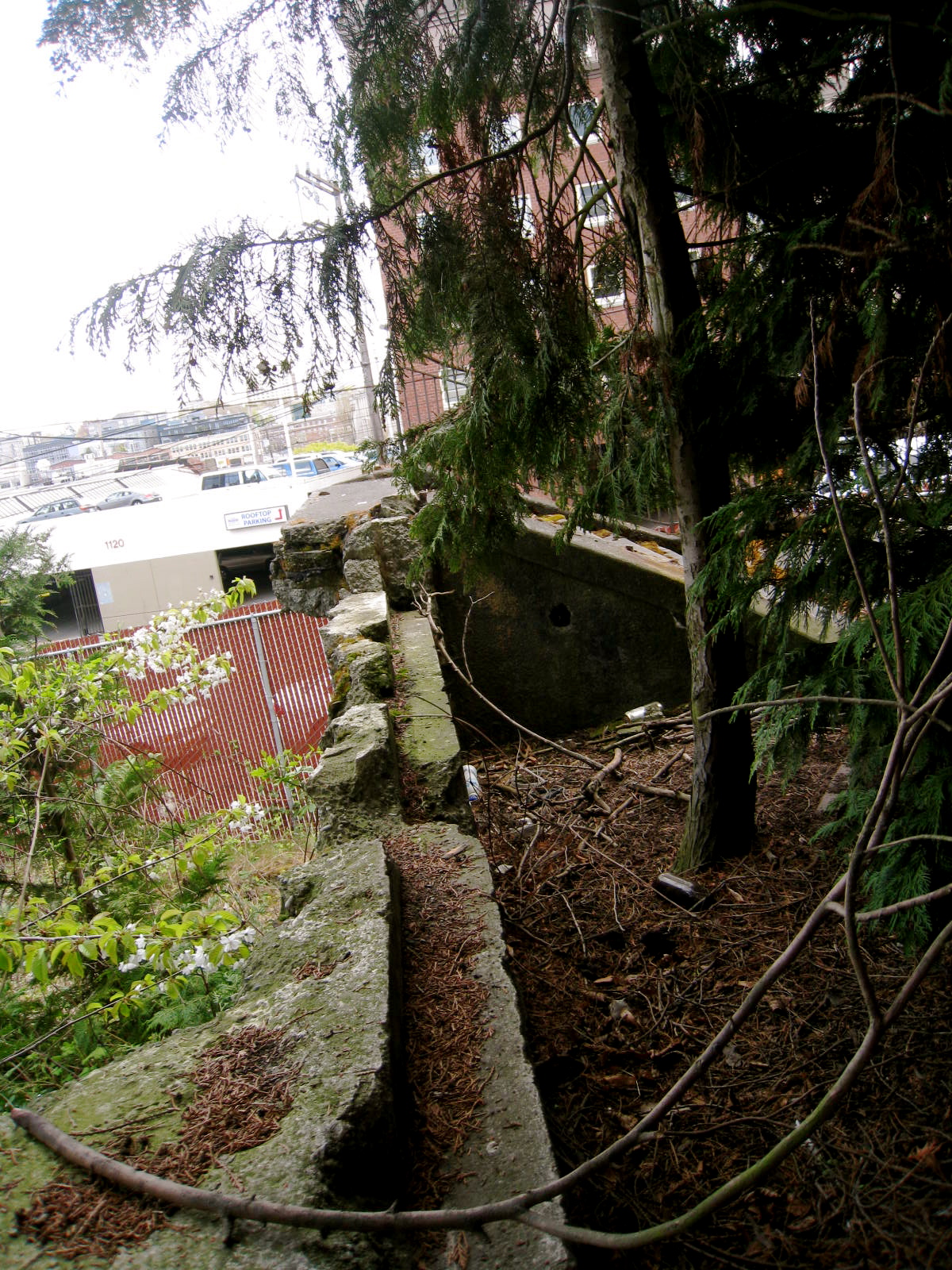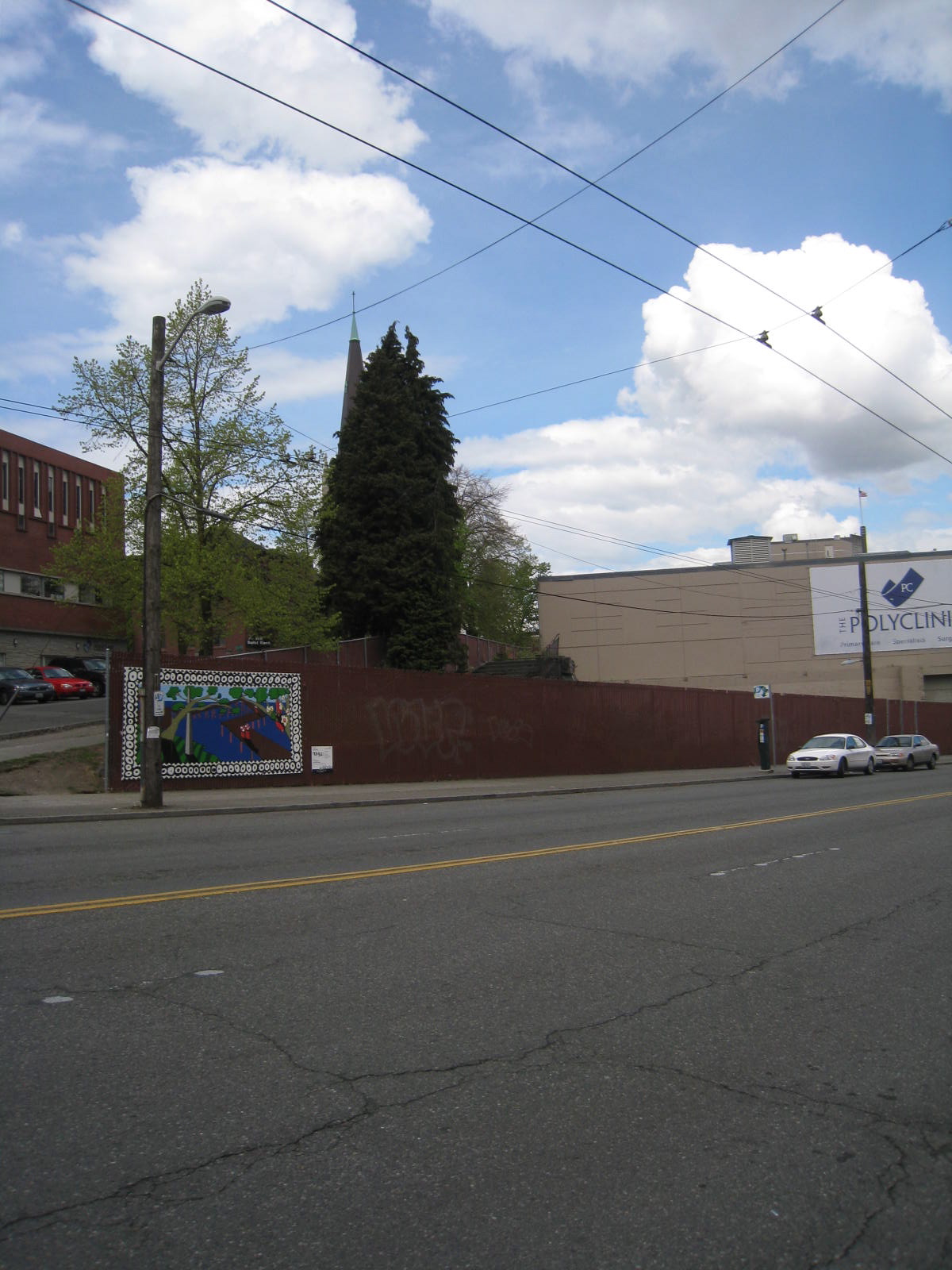There’s a triangle where Broadway and Harvard meet just north of Madison Street that has been fenced for years. Behind the fence is a concrete stairway with a railing — but the building is no longer there. It’s a stairway to nowhere.
This was the old Scottish Rite Cathedral, which opened in 1911 and remained in use by the Scottish Rite until the late 1950s. The building was actually built in the old Spring Street right-of-way which was vacated by the city in March of 1891, long before the Masonic Temple Association bought the land in August of 1910.
Flash forward 100 years and find a fenced empty lot full of surprisingly hearty weeds and an ambitious clutch of trees. Earlier this week, CHS talked to the owner of this strange patch of Capitol Hill about their development plans for the area. The Polyclinic, we learned, has big plans for most of its Capitol Hill holdings.
But this lot is a conundrum.
 Scottish Rite Cathedral, image courtesy of Vintage Seattle
Scottish Rite Cathedral, image courtesy of Vintage Seattle
The building that used to stand there was designed and built by builder Frank Allen. It was a two-story frame building over a full story concrete basement floor. The entrance faced south, toward Madison Street but the easiest access was from Harvard and you can still see that from the sidewalk. There’s a nice photograph by Asahel Curtis dated 1912 which shows the building from Harvard Avenue so that one can see the pillars and the double eagle that is the symbol of the Ancient and Accepted Scottish Rite of Freemasonry.
When it was built, the Scottish Rite Cathedral was across Broadway from Christensen’s Dance School (now the Silver Cloud Hotel), across Harvard from Minor Hospital (the building is still there), and next door to St. Mark’s Episcopal Church (now moved to St. Mark’s Cathedral at 1245 10th Avenue E.).
The Scottish Rite folks built a new center up north on Broadway in about 1960 at 1155 Broadway East, but that building too has been demolished. The Scottish Rite group left our neighborhood, but they still exist, as do many other groups of freemasons who have been a part of Seattle and Washington’s history since before statehood.
 Today, the Polyclinic owns a parcel of land its officials don’t really have a plan for, according to spokesperson Tracy Corgiat. “We have had a lot of ideas on that lot,” Corgiat said. “We’ve done everything from thinking what a great park we could make to considering it as part of our expansion.” But Corgiat said engineers have determined that the slope of the land and other factors make the lot to complicated — and expensive — to develop. “We thought ‘Let’s have more than weeds!’ at one time,” Corgiat said, saying that the Polyclinic even considered having a work party to clean up the lot and turn it into a low budget open area.
Today, the Polyclinic owns a parcel of land its officials don’t really have a plan for, according to spokesperson Tracy Corgiat. “We have had a lot of ideas on that lot,” Corgiat said. “We’ve done everything from thinking what a great park we could make to considering it as part of our expansion.” But Corgiat said engineers have determined that the slope of the land and other factors make the lot to complicated — and expensive — to develop. “We thought ‘Let’s have more than weeds!’ at one time,” Corgiat said, saying that the Polyclinic even considered having a work party to clean up the lot and turn it into a low budget open area.
Back in June 2009 when the City Council passed legislation making it possible for Polyclinic to develop its East Union land for a medical facility, Betsy Hunter of Capitol Hill Housing told CHS about her hopes that the Polyclinic would think creatively about the space. “That strange shaped lot could be landscaped with a staircase to bring pedestrians up to First Hill,” Hunter said. “A plaza could be created across from Seattle University with a pedestrian area to walk though a landscaped courtyard before entering the new building with parking for the church and the Polyclinic, retail, offices and housing. All of it could happen with partnerships and the rezone.”
Chip Nevins from Seattle Parks said his department has considered how to put the triangle to use but says, thus far, the space lacks the community support needed to push a project forward. “We’ve known about it forever,” Nevins told CHS.
“We don’t have any funding to direct to that spot. We’ve had other priorities,” Nevins said. “This one has no champion.”
 Back before it became an empty space and after the Scottish Rite Masons moved up Broadway, the building that called the lot home was renovated and became “Music-Go-Round,” a venture by emerging theater folks and UW graduates Jerry Sando and William J Dore Jr. both of whom lived on Capitol Hill at the time. The theater opened on October 31, 1961 with “Cancan” and continued to offer musical theater until they ran out of money and closed in February 1962. Both Sando and Dore went on to long careers in theater — Sando was perhaps best known as “Bozo” the clown on KING-TV and Dore taught drama for decades at Seattle University. The theater never reopened.
Back before it became an empty space and after the Scottish Rite Masons moved up Broadway, the building that called the lot home was renovated and became “Music-Go-Round,” a venture by emerging theater folks and UW graduates Jerry Sando and William J Dore Jr. both of whom lived on Capitol Hill at the time. The theater opened on October 31, 1961 with “Cancan” and continued to offer musical theater until they ran out of money and closed in February 1962. Both Sando and Dore went on to long careers in theater — Sando was perhaps best known as “Bozo” the clown on KING-TV and Dore taught drama for decades at Seattle University. The theater never reopened.
In the very late 1970s the building became Stop & Shop on Broadway, an antique ahop. This is likely when it acquired the blue/green paint job that some of us remember from about 1980 on. Then in the mid-1980s, Club Broadway began at 1111 Broadway. While this is not the 1115 address that was being used at the time for the old Scottish Rite Temple building, it is consistent with its location and a music wiring chart on line for the club certainly looks like the shape of the old building. John H. Schloredt is listed as “president” of the Club in the street directory for 1985. The Club lasted until about 1988. (We would be delighted to hear confirmation of this if anyone remembers the place, rumored to be an all ages dance club with the DJ in a giant jukebox. Perhaps techno?) And then it went vacant again.
The building was owned by the Polyclinic since at least the 1980s, if not before. It appears in the street directory without a telephone until 2002, when it is not listed, and presumably demolished except for the staircase which still stands today.
Dotty DeCoster is a regular contributor to CHS on matters of Hill history. We last featured her work in this article about the steam the flows beneath the streets of Capitol and First Hills, Where the Harvard and Pike steam comes from


